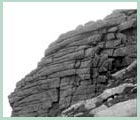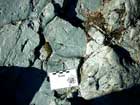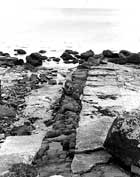| ENVIRONMENTS
- Volcanoes
The landscape
on Arran is dominated by the remnants of ancient volcanoes produced in
the Tertiary when the North American and Eurasian continents rifted apart
to create the north Atlantic Ocean. Continental rifting is intimately
associated with magmatic activity, and features such as the exposed roots
of volcanoes, sills, and lava flows can all be seen on Arran.
   The
Northern Granite on Arran, which forms the highest peak on the island,
is in fact the roots of a volcano which was active about 60 Ma years ago.
The characteristic volcano shape no longer exists; it has been removed
by glaciation. What remains is the solidified magma that existed beneath
the volcano which had time to cool at depth and become granite. Due to
the slow cooling the resulting rock is coarsely crystalline and very resistant
to weathering. It is very easy to identify the constituent minerals with
the naked eye: quartz, feldspar, mica. Goat Fell is the highest peak on
Arran and is composed of entirely of granite. The shrinking and cracking
pattern produced upon cooling and exhumation of granite is called tor. The
Northern Granite on Arran, which forms the highest peak on the island,
is in fact the roots of a volcano which was active about 60 Ma years ago.
The characteristic volcano shape no longer exists; it has been removed
by glaciation. What remains is the solidified magma that existed beneath
the volcano which had time to cool at depth and become granite. Due to
the slow cooling the resulting rock is coarsely crystalline and very resistant
to weathering. It is very easy to identify the constituent minerals with
the naked eye: quartz, feldspar, mica. Goat Fell is the highest peak on
Arran and is composed of entirely of granite. The shrinking and cracking
pattern produced upon cooling and exhumation of granite is called tor.
 When
a volcano erupts it can either be explosive (pyroclastic) or effusive
(lava flow). There are lava flows associated with the Clyde Plateau Volcanic
Formation, erupted during the Carboniferous, which can be seen exposed
on the shore at Corrie. The lava flows are composed of basalt, a fine
grained basic igneous rock, which often contains phenocrysts of olivine
and plagioclase. When
a volcano erupts it can either be explosive (pyroclastic) or effusive
(lava flow). There are lava flows associated with the Clyde Plateau Volcanic
Formation, erupted during the Carboniferous, which can be seen exposed
on the shore at Corrie. The lava flows are composed of basalt, a fine
grained basic igneous rock, which often contains phenocrysts of olivine
and plagioclase.
  The
oldest volcanic rocks on Arran are of suspected Ordovician age, and are
submarine in origin. Erupted under water, the magma solidifies in a particular
lumpy fashion, hence the name pillow lava. Pillow lavas and volcanic agglomerate
can be seen in the North Glen Sannox burn (NR996469). The
oldest volcanic rocks on Arran are of suspected Ordovician age, and are
submarine in origin. Erupted under water, the magma solidifies in a particular
lumpy fashion, hence the name pillow lava. Pillow lavas and volcanic agglomerate
can be seen in the North Glen Sannox burn (NR996469).
  The
magma associated with volcanoes often does not reach the surface and instead
exploites weaknesses in the country rock to form intrusive igneous rocks
like dykes and sills. Excellent composite intrusions known as Judd’s
Dykes, which display a suite of cogenetic igneous rocks, can be seen at
the shore near An Cumhann just north of the Kings Caves on the west coast. The
magma associated with volcanoes often does not reach the surface and instead
exploites weaknesses in the country rock to form intrusive igneous rocks
like dykes and sills. Excellent composite intrusions known as Judd’s
Dykes, which display a suite of cogenetic igneous rocks, can be seen at
the shore near An Cumhann just north of the Kings Caves on the west coast.
|

